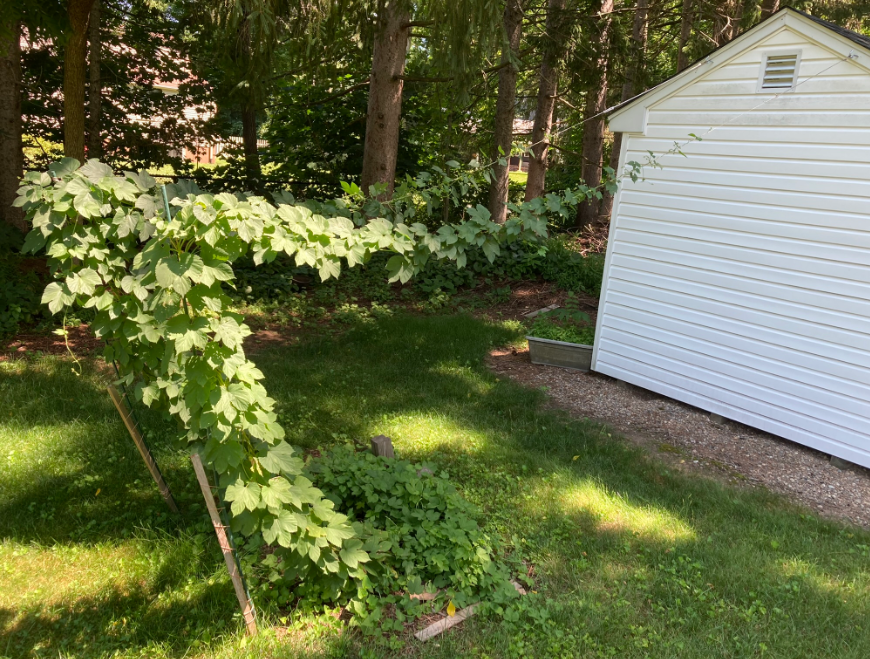I grew hops for years in Carlsbad NM, a truly inhospitable place for hops because of the summer heat and dryness. When we moved to Silver City, much higher in elevation and much cooler I brought my rhizomes, and they all died immediately. The past 3 springs I've bought plants or rhizomes, the first 2 years the plants all died within a month. Last year was my final attempt. I rebuilt the soil with homemade compost and this year all my plants are doing great. I have Cascade, Liberty, Magnum and Willamette-an odd combination but I wanted to make sure something would survive. So far the Cascade and Liberty are well over a foot tall, Magnum and Willamette are about a foot tall.
You are using an out of date browser. It may not display this or other websites correctly.
You should upgrade or use an alternative browser.
You should upgrade or use an alternative browser.
My hops survived and are thriving
- Thread starter corkybstewart
- Start date

Help Support Homebrew Talk - Beer, Wine, Mead, & Cider Brewing Discussion Forum:
This site may earn a commission from merchant affiliate
links, including eBay, Amazon, and others.
I rebuilt the soil with homemade compost and this year all my plants are doing great.
I started off keeping my hops potted. They can do a lot given just a little compost.
That said, my Nugget really took off after I planted them in the ground.
On one of my computers I have a picture of a 5 year old Cascade crown that completely filled a lawn chair. I can't afford pots that big.I started off keeping my hops potted. They can do a lot given just a little compost.
That said, my Nugget really took off after I planted them in the ground.
Planted 2 Columbus last spring and only one grew. This year the idle one has poked through. It is far behind its neighbor this season, but I assumed it was dead, yet left the location idle.
Edit: Although the young sprout looked similar, this of course turned out to not be a hop. Just a weed. But my 2nd year single Columbus that did survive is out-pacing the two 2nd year Nuggets.
Edit: Although the young sprout looked similar, this of course turned out to not be a hop. Just a weed. But my 2nd year single Columbus that did survive is out-pacing the two 2nd year Nuggets.
Attachments
Last edited:
I tried twice, none of them survived a month. But now that I seem to have my soil issues solved I may try once again. The wild Neomexicanus come from much higher elevations, in much colder areas.Wouldn't Silver city be in a good spot to try Neomexicalus?

Cascade, 2nd year.
Because of the quantity and variety of critters determined to eat my crops the garden is fenced like Fort Knox-3 layers of chickenwire to keep the packrats and rock squirrels out, field wire to stop the deer, javelina and cows, and chickenwire roof to stop the bigger birds. It limits how high the bines can grow but they spread out over the fence very well.
- Joined
- Nov 26, 2013
- Messages
- 7,648
- Reaction score
- 14,531
I appreciate the lengths to which you've gone for protection, but my first thought was "how in the heck would I extricate twisty hop bines that have essentially molecularly bonded/twisted themselves into wire fencing?"Because of the quantity and variety of critters determined to eat my crops the garden is fenced like Fort Knox-3 layers of chickenwire to keep the packrats and rock squirrels out, field wire to stop the deer, javelina and cows, and chickenwire roof to stop the bigger birds. It limits how high the bines can grow but they spread out over the fence very well.
My hops seem to have taken this year off and have not grown nearly as robustly. Normally they would be up to the shed roof before burring and flowering and this year are 5-6 feet shy of the shed. Perhaps because I did not cut them back in May when first shoots were a foot high.

That's an issue I'll have to figure out. I have some ideas, but the details are fuzzy at best. In the past I had magnums that grew on a chainlink fence-that was easy to harvest and the bines produces as well as any that were vertical. This garden fence is low enough i can pick the cones from a short ladder, but the goal last year was to see if I could make them survive.I appreciate the lengths to which you've gone for protection, but my first thought was "how in the heck would I extricate twisty hop bines that have essentially molecularly bonded/twisted themselves into wire fencing?"
My hops seem to have taken this year off and have not grown nearly as robustly. Normally they would be up to the shed roof before burring and flowering and this year are 5-6 feet shy of the shed. Perhaps because I did not cut them back in May when first shoots were a foot high.
View attachment 775026
When I met with Sylvain and a hop farmer in France a couple of weeks ago one of my questions was about critters eating the plants. After that conversation I have an idea for caging the bottom 5 or 6 feet and running string to tree branches for height.
mashpaddled
Well-Known Member
Yeah I suspect you'll regret the chicken wire because getting the bines out of that after harvest is going to be a nightmare.
I'll handpick this year and move them this fall to a better situation.Yeah I suspect you'll regret the chicken wire because getting the bines out of that after harvest is going to be a nightmare.
Similar threads
- Replies
- 31
- Views
- 1K
- Replies
- 4
- Views
- 1K


